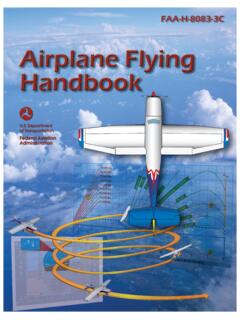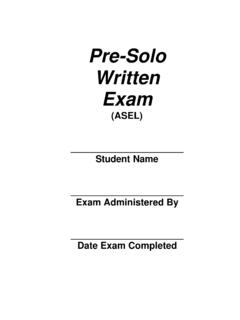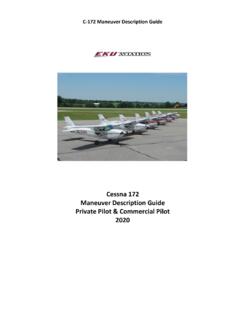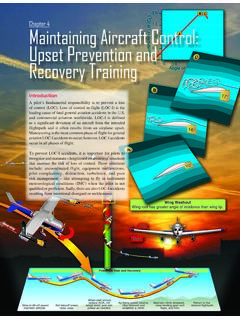Transcription of INSTRUMENT STAGE CHECK ORAL GUIDE - Coast Flight …
1 INSTRUMENT STAGE CHECK ORAL GUIDE (REVISION I) REFERENCES FAR/AIM IPH IFH AC 00-45G AC 00-6A PHAK POH RECOMMENDED READINGS Selected Advisory Circulars 120-57 Surface Movement Guidance Control System 120-91 Airport Obstacle Analysis 90-100 RNAV Operations 20-138 Airworthiness of Navigation Systems 120-71 SOP for Flight deck crew members 90-101 RNP certification 97-1 RVR Certificates and Documents How long is your pilot certificate valid? ( c) Your pilot certificate is issued without a specific expiration date What privileges and limitations apply to you as a private pilot? ( ) ( ) Privileges Act as PIC and carry passengers conduct search and rescue operations; fly for charitable, non-profit, or community event; act as an aircraft salesman if you have at least 200 hours.
2 Limitations Cannot fly for hire; must pay no less than pro rata share What documents must you have with you to fly the airplane? ( ) Pilot certificate, medical certificate, and government issued photo ID How long is a medical certificate valid for? ( ) Under 40 40 and Older How do we keep our pilot certificate current? ( , ) Student pilot: with valid medical certificate PPL: Flight review every 24 calendar months What are the currency requirements for carrying passengers? ( ) 3 take offs and landings within the preceding 90 days in an aircraft of the same category, class and type if required. At night, these 3 landings must be made to a full stop. Night definition? When can you perform required night landings? ( , ) Night = the time between evening civil twilight and morning civil twilight Night landings can be logged 1 hour after sunset to 1 hour before sunrise. When is an INSTRUMENT rating required? ( (v)(e) (4) (i) (ii)) In Class A airspace Operating under IFR Anytime the weather is beneath VFR minimums: Ceiling below 1000 or visibility less than 3 miles Anytime you are operating special VFR at night What are the recency-of-experience requirements to be PIC of a Flight under IFR?
3 ( ) Within the preceding 6 months of the Flight , 6 INSTRUMENT approaches and holding procedures and intercepting and tracking courses must be completed either in actual IMC, in VMC while using a view limiting device, or in a Flight simulator/FTD. Define appropriately rated safety pilot. ( ) The safety pilot must possess at least a private pilot certificate with the category and class ratings appropriate to the aircraft being flown and he/she must have adequate vision forward and to each side of the aircraft. If a pilot allows his/her INSTRUMENT currency to expire, what can be done to become current again? ( ) If you fail to meet the INSTRUMENT experience requirements for more than 6 months, the only way to reestablish currency is with an IPC. What aircraft/ instruments /equipment are required for IFR operations? ATOMATOFLAMES, FLAPS, and GRABCARD ( ) Generator/alternator Radio Altimeter (adjustable) Ball (inclinometer) Clock w/ hours, minutes, and seconds Attitude indicator Rate of turn indicator Directional gyro *DME is required at or above FL240 if VOR navigation is required What are the required tests and inspections of aircraft and equipment to be legal for IFR Flight ?
4 AVIATES Annual every 12 calendar months ( ) VOR every 30 days for IFR ( ) 100 hour if airplane is being operated for hire ( ) Altimeter/Pitot Static 24 calendar months; required for IFR Flight ( ) Transponder 24 calendar months ( ) ELT 12 calendar months or after 1 hour cumulative use or half of battery life ( ) Service bulletins and ADs complied with (PHAK 8-12) What are the different methods for checking the accuracy of VOR equipment? ( ) (IPH 2-29) VGAAD VOT Ground CHECK Airborne Airway Dual VOR What records must be kept concerning VOR checks? Date, place, bearing error, and signature Where can you find the location of airborne, ground and VOT testing stations? Chart Supplement (see back cover) What documents need to be on board an aircraft to make it legal for IFR Flight ? ARROW ( , ) Airworthiness Certificate Registration Radio License (required for international Flight ) Operating Limitations (found in the POH) Weight and Balance equipment list Aircraft Systems (PHAK Chapter 7) (IFH Chapter 5) (POH) Describe the pitot-static Flight instruments Airspeed Indicator This is the only INSTRUMENT that uses both the pitot and static ports.
5 It measures the difference between dynamic pressure (ram air entering the pitot tube) and static pressure (air that is unaffected by the aircraft s Flight path). Ram air exerts a force on a diaphragm inside of the INSTRUMENT . The INSTRUMENT case is full of static air. Altimeter This measures the difference between static pressure inside of the INSTRUMENT case and standard pressure ( Hg) sealed inside of an aneroid wafer. When the airplane is climbing and ambient pressure begins to decrease, the wafer is able to expand because the air that is sealed inside is now of higher pressure. The altimeter is a sensitive altimeter meaning that it can be calibrated to the local barometric pressure by adjusting the Kollsman window. VSI Measures the difference between static pressure and static pressure that is subject to a calibrated leak approximately every 6-9 seconds. How do the pitot- static instruments respond to blockages? *Note the very first error this error would be highly uncommon in the Piper Archer because there is no drain hole on the pitot mast like most other training aircraft.
6 If there is a blockage in the pitot mast, the drain hole would more than likely be unaffected. Describe the gyroscopic instruments The Gyroscopic instruments are powered by an engine driven vacuum pump with the exception of the turn coordinator which is electrically powered. The two principles that gyroscopes operate off of are: Rigidity in space: while spinning, a gyroscope will tend to stay fixed in its plane of rotation. Think of a bicycle wheel. With enough momentum, you are able to stay naturally balanced. Precession: when a force is applied to a gyroscope, the resultant force is felt 90 ahead in the direction of the rotation. Attitude Indicator Rotates in the horizontal plane and operates off of the principle of rigidity in space. The aircraft pitches and rolls around the erect gyroscope. The effects of precession are not felt because pendulous vanes attached to the base of the gyro duct high pressure air from the vacuum through small doors that open and close by the force of gravity to keep the gyro in its original position.
7 Heading Indicator Rotates in the vertical plane and operates off of rigidity in space as well. As the aircraft yaws around the gyro, a gear inside of the INSTRUMENT case rotates the compass card to show the magnetic direction. Precession caused from aircraft movement and friction causes error that must be corrected by resetting the heading indicator to the magnetic compass approximately every 15 minutes. Turn Coordinator This electrically powered gyro rotates in the vertical plane and it uses precession to measure rate of turn and rate of roll. When the aircraft yaws, the gyro precesses and the airplane on the face of the INSTRUMENT indicates the direction and rate of the turn. Notice in the diagram of the INSTRUMENT that it is slightly canted upwards. This is so rate of roll can be indicated as well. When the aircraft begins a bank the aircraft will also indicate the direction of the bank. If it is a rapid roll the airplane will respond by banking more steeply.
8 Once the turn is established it will properly indicate the rate of the turn. What is the difference between the turn coordinator and the turn and slip indicator? How does the vacuum system operate? (PHAK 7-17) (POH 7-17) (IFH 5-17) An engine driven vacuum pump creates suction. Air is pulled through a filter and then directed to the INSTRUMENT case. Rotor vanes on the gyros catch the air like a water wheel and cause it to rotate at a high speed. In the Archer IIIs, there is also an electrical vacuum pump to be used as a backup. Explain the errors associated with the magnetic compass. Variation Since the magnetic north pole and the geographic North Pole are not collocated, we need to consider this when planning flights. Easterly variation is subtracted from true heading while westerly variation is added to get our magnetic heading. Remember: East is least and West is best! Deviation Since a compass depends on aligning with the Earth s magnetic fields to read accurately, any kind of other local magnetic fields will cause an error known as deviation.
9 This other magnetic fields are produced from electrical currents from the aircraft avionics and varies on different headings. The compass correction card located on the compass tells the pilot which compass heading to steer to for a desired magnetic heading. Dip Errors While flying on a north or south heading, these turning errors are most pronounced. While flying a north heading and turning to the left, the compass will initially show a turn in the opposite direction and lag behind the turn. When on a south heading, the compass will lead the turn and show that the turn is being made a much faster rate than it actually is. *Imagine that north is home to the compass. While at home the compass wants to stay there during a turn and will lag behind before it finally decides to catch up reluctantly. Conversely, while most far away from home on a south heading, when a turn is commenced, the compass gets excited and races there (leading the turn) Northerly Turning Error CG displacement of the float assembly in the compass causes false turn indications.
10 When turning to the north, the turn should be stopped prior to arrival at the desired heading. When turning south, turn pass the desired heading. The rule is: UNOS Undershoot North Overshoot South Acceleration Error While on east or west headings, acceleration results in a slight turn to the north. Deceleration results in a slight turn to the south. The rule is: ANDS Accelerate North Decelerate South Oscillation Error A combination of all of these errors and results in the compass swinging back and forth around the headings being flown Navigational Equipment (AIM Chapter 1) (PHAK Chapter 15) (IFH Chapter 9) What is an HSI? (IFH 5-15) The Horizontal Situation Indicator combines the functions of the heading indicator and the VOR receiver into one INSTRUMENT display. The major benefit is that most of the reverse sensing problems associated with a VOR receiver are precluded. This is because when an HSI is tuned to a VOR station, a course deflection of left or right always mean left or right notwithstanding the course you select with the course indicating arrow.









